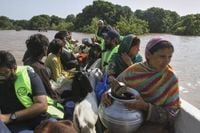In a dramatic turn of events along the Indus River, authorities in Pakistan’s southern Sindh province have undertaken a massive evacuation effort, moving more than 100,000 people from low-lying areas as floodwaters threaten to surge downstream. The operation, confirmed by Sindh Information Minister Sharjeel Memon, comes on the heels of an urgent warning from neighboring India, which notified Islamabad through diplomatic channels on September 5, 2025, about the potential for cross-border flooding due to dam water releases. This development marks the latest chapter in a summer of relentless monsoon rains and swelling rivers that have already left a devastating mark on Pakistan’s landscape and its people.
According to the National Disaster Management Authority (NDMA) and local officials, the warning from India was prompted by the release of water from upstream dams, a measure that, while necessary for managing India’s own flood risk, has downstream consequences for Pakistan. The Ravi, Sutlej, and Chenab rivers—already swollen from heavier-than-normal monsoon rains—burst their banks about two weeks ago, inundating some 3,900 villages in the eastern Punjab province. The resulting deluge has displaced approximately 1.8 million people since August, according to reports from The Associated Press and The Irish News.
“Evacuations are underway in vulnerable districts,” stated Sharjeel Memon, “with 109,320 people already moved to safer ground as water levels in the Indus rise.” The scale of the operation is staggering: thousands of rescuers, backed by the military, are working around the clock in Punjab’s Muzaffargarh and Multan districts, delivering food and aid to those forced from their homes. Images from the region show volunteers ferrying villagers through waist-deep waters, their faces etched with worry and exhaustion as they search for higher ground.
The broader context is sobering. Since late June 2025, monsoon flooding has killed more than 900 people across Pakistan, disaster officials confirmed. The country’s vulnerability to such disasters is well known—Sindh, in particular, was among the worst-hit regions in the catastrophic 2022 floods, which claimed 1,739 lives nationwide. For many, the memory of that tragedy is still fresh, and the current crisis has revived fears of a repeat scenario.
“Deluges are now moving downstream towards Sindh, where they could swell the Indus River,” officials warned, underscoring the urgency of the evacuation. The Indus, one of Asia’s great rivers, is both a source of life and, in years like this, a harbinger of destruction. When the river’s banks are breached, entire communities can be submerged in a matter of hours. The authorities’ swift action this time—prompted in part by India’s timely notification—may help prevent even greater loss of life, but the scale of displacement is already immense.
In Punjab, the situation remains dire. The combination of weeks-long monsoon rains and water releases from Indian dams has created a perfect storm, pushing rivers to dangerous levels. In Muzaffargarh and Multan, military helicopters and boats are being used to reach stranded villagers. “Thousands of rescuers, supported by the military, are delivering food to other displaced people in Muzaffargarh and Multan districts in Punjab, where floods have inundated 3,900 villages,” reported The Associated Press. The logistical challenges are immense: roads have been washed away, communications disrupted, and access to clean water and medical supplies is limited.
Officials say the evacuations in Sindh are focused on the most vulnerable districts—areas that lie closest to the river and are at the greatest risk if floodwaters continue to rise. The government has set up temporary shelters and is working to provide basic necessities, but the sheer number of displaced people is straining resources. For many families, the evacuation means leaving behind homes, livestock, and crops—their entire livelihoods—in the hope of returning once the waters recede.
The response from local and national authorities has been swift, but the crisis has also exposed the persistent challenges Pakistan faces in disaster preparedness and response. In recent years, the country has made efforts to improve early warning systems and strengthen coordination with neighboring countries like India. The diplomatic notification from India about the dam releases, for example, was a critical factor in the timing of the evacuations. Yet, as the events of this summer have shown, even the best-laid plans can be overwhelmed by the sheer force of nature.
As the floodwaters move downstream, attention is turning to the long-term impacts. The displacement of 1.8 million people in Punjab alone is likely to have lasting consequences for food security, public health, and local economies. In the short term, the focus remains on saving lives and providing relief to those affected. But officials and experts alike are warning that the country must do more to address the root causes of its vulnerability—ranging from deforestation and poor land management to climate change, which is making extreme weather events more frequent and severe.
The memory of the 2022 catastrophe looms large over the current crisis. That year, Sindh was devastated by floods that killed nearly 1,800 people and displaced millions. The scars of that disaster are still visible, both in the physical landscape and in the collective psyche of the region’s residents. For many, the latest evacuations are a painful reminder of the recurring dangers they face every monsoon season.
Despite the challenges, there are glimmers of hope. The rapid response by rescuers—many of them volunteers—has saved countless lives. The coordination between provincial and national authorities, as well as the timely communication from India, has helped avert an even greater tragedy. Yet the road to recovery will be long, and the true toll of the floods may not be known for weeks or months.
As the Indus River continues its relentless journey southward, carrying with it the hopes and fears of millions, the people of Sindh and Punjab are bracing for whatever comes next. For now, the focus remains on survival, but the broader questions—about preparedness, resilience, and the need for regional cooperation—will linger long after the waters recede.
Pakistan’s latest flood crisis is a stark reminder of the country’s ongoing battle with nature’s unpredictability and the urgent need for sustained investment in disaster risk reduction. As families seek shelter and communities rally to support one another, the nation faces a familiar but daunting challenge—one that will test its resolve and its capacity to protect its most vulnerable citizens.


